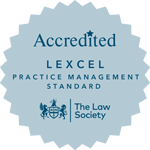A brief guide to the ‘chain of causation’.
It’s mentioned elsewhere on this site that the three elements you need to establish in a claim for professional negligence are:
1. A duty of care was owed;
2. That duty was breached; and
3. A loss was suffered.
However, we could add a fourth requirement to that list, linking the breach and the loss.
4. “Causation”.
As I have just settled a case where causation was a key issue in dispute, I thought I’d touch on it here.
At its most basic level, causation is very simple: did the breach cause the loss? Or as that great legal encyclopaedia Wikipedia says “causation is the causal relationship between conduct and loss”.
The usual legal test is the ‘but for’ test: ‘but for the action of X, I would not have suffered this loss’. However, there is a limit to this test. Technically, if you follow this argument to its ultimate conclusion by reductive logic, you could say that ‘but for’ the Defendant being born, this act would not have happened. That takes it too far, so there are limits and of course, it comes down to that ubiquitous gent on the Clapham omnibus to adjudicate on what would be considered reasonable and foreseeable. But that is an article for another day.
Let me put this into context.
My clients wanted to purchase a house. It was a private sale so there hadn’t been an independent valuation. The seller wanted £450,000. I have seen the photos of the house and after all the work my clients have undertaken, it is a truly stunning property. However the early photos show that some work was definitely needed. Even so, it was still relatively unique, sat in a large plot of land and one of its previous owners had been rather famous (think heavy metal Rock ‘God’!).
Because my clients needed a mortgage, a valuation was carried out on the premises. I am sure you are aware that when it comes to valuations, the surveyor carries out a comparison test – what other properties in the area are similar? What price did they sell for? As my client’s house was a singular property, there weren’t too many comparables but despite this, the surveyor valued the property at £400,000.
The vendor wouldn’t come down in price but my clients liked the property, could see that there was a lot of potential to improve it and quite frankly, they saw it as their ‘forever home’. It was worth spending the extra £50,000 to get the property. So this is what they did.
Move forward a few years. When my clients tried to remortgage the property they got a bit of a shock. Despite a large amount of work having been done, the property was worth less than when they had purchased it. Carrying out some research, they found an obscure reference to a valuation having been carried out on the property a couple of months before theirs had been undertaken. The shock was that the property had been valued at £280,000 – £120,000 less than their own valuation only two months later.
There was some quite substantial argument between the two experts in the subsequent litigation. Our expert agreed that the earlier valuation of £280,000 was pretty spot on; the other side’s expert disagreed and although he valued the property at less than the valuation carried out by the Mortgage Valuer, it was nowhere near the figures we were citing.
However, that is not the point of this article, which is about causation. Our claim against the Defendant was for the sum of £170,000 – the difference between the price paid (not the figure in the mortgage valuation which you will recall was £50,000 lower) and our expert’s valuation. A huge argument arose about the extra £50,000. The Defendants stated that there was not a causal link between the valuation of £400,000 and the price paid by my clients. They argued that in making the decision to pay the extra £50,000, they had not relied on the valuation at all: they wanted the house and were willing to pay the price for it, regardless of the mortgage valuation.
It is actually a very good argument. If the mortgage valuation was for £400,000, how can it have caused the client to lose money over and above that sum? It was an overspend that they chose to accept. Clearly, they did not rely on the report.
Understandably, we countered that line of argument especially as there is an obscure case called Kenney v Hall, Pain & Foster [1976] 2 EGLR 29 which was analogous to my clients’ situation. In that case, Mr Kenney obtained a valuation which he felt was rather high and over-egged the pudding somewhat. He bought the property at the higher price but when it transpired the valuation was way off – more than he had realised – he sued. The reliance argument was raised in that case as well. The Court concluded though that whilst Mr Kenney took into account other factors in deciding to purchase the property at a value higher than what he thought it was worth, it concluded that the valuation was still an important consideration in that:
“the valuation made him feel that he could safely commit himself to spending £65,000 on Wickham Lodge and cover his commitments…. He felt that, in light of the advice that he had received from [the defendants], even allowing that his valuation might have been rather high, this was a risk that he could safely take.”
This is the line of argument we took. My clients were prepared to pay more than the valuation but not infinitely more. An extra £50,000 on a property worth £400,000 was bearable; an extra £170,000 on a property worth £280,000 was not. A valuation of £400,000 gave them the requisite comfort that £450,000 was not a wild overpayment.
So how did it end? Sadly, not the way that I would have liked. A very low offer was made to my clients and although I strongly advocated against accepting it, at the end of the day, the decision was theirs and they went for it. They had had enough of the whole thing. They had been worrying themselves sick for six years before they instructed me, wondering how to cope with the negative equity in their property, not knowing they could bring a claim. The experts had been hotly contesting each others conclusions and quite frankly, my clients just wanted to move on.
Would we have recovered a higher sum at trial? I am pretty certain of it. If proceedings had actually been issued, I could have applied to the Court for an order that the early valuation of £280,000, that had sparked all this off, be released to us. It would most certainly have popped the Defendant’s expert’s arguments on valuation. And there is enough case law to pop the causation argument too. But there you go. You win some and you lose some and whilst this was technically a ‘win’, I’d have loved to have taken this one to court and have got more money for my client.


